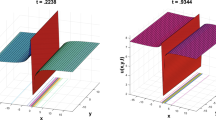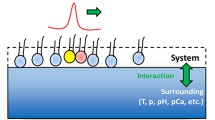Abstract
Experiments show that elastic constants of lipid bilayers vary greatly during the liquid-to-gel phase transition. This fact forms the cornerstone of the Heimburg–Jackson model of soliton propagation along membranes of axons, in which the action potential is accompanied by a traveling phase transition. However, the dispersion term, which is crucial for the existence of solitons, is added to the Heimburg–Jackson model ad hoc and set to fit experimental observations. In the present paper, we aim to consolidate this view with continuous membrane mechanics. Using literature data, we show that the compression modulus of a DPPC membrane is smaller by approximately an order of magnitude during phase transition. With a series expansion of the compression modulus, we write the action of a membrane and solve the corresponding wave equation analytically using an Exp-function method. We confirm that membrane solitons with speeds around 200 m/s are possible with amplitudes inversely proportional to their speed. We conclude that dispersion necessary for existence of solitons is directly related to a membrane’s bending properties, offering a possible explanation for h. Our findings are in general agreement with existing literature and give insight into a general mechanism of wave propagation in membranes close to transition.
Graphical abstract






Similar content being viewed by others
Data Availability
The datasets generated during and/or analyzed during the current study are available from the corresponding author on reasonable request.
Change history
11 October 2022
A Correction to this paper has been published: https://doi.org/10.1140/epje/s10189-022-00236-9
References
T. Heimburg, A.D. Jackson, On soliton propagation in biomembranes and nerves. Proc. Natl. Acad. Sci. 102(28), 9790–9795 (2005)
Thomas Heimburg, Thermal Biophysics of Membranes (John Wiley & Sons, US, 2008)
On the role of the phospholipid membrane in free energy coupling. https://www.nbi.ku.dk/membranes/Kaufmann/publications.html. Accessed: 13-08-2022
Gerald H. Pollack, Cells, gels and the engines of life: a new, unifying approach to cell function (Ebner & Sons Seattle, WA, 2001)
J.M. Ritchie, R.D. Keynes, The production and absorption of heat associated with electrical activity in nerve and electric organ. Q. Rev. Biophys. 18(4), 451–476 (1985)
I. Tasaki, P.M. Byrne, Heat production associated with a propagated impulse in bullfrog myelinated nerve fibers. Jpn. J. Physiol. 42(5), 805–813 (1992)
B. Lautrup, R. Appali, A.D. Jackson, T. Heimburg, The stability of solitons in biomembranes and nerves. Eur. Phys. J. E 34(6), 1–9 (2011)
L.D. Mosgaard, A.D. Jackson, T. Heimburg, Low-frequency sound propagation in lipid membranes. Adv. Planar Lipid Bilayers and Liposom. 16, 51–74 (2012)
X. Gràcia and T. Sanz-Perela. The wave equation for stiff strings and piano tuning. Reports@SCM 3, 1–16 (2017). https://doi.org/10.2436/20.2002.02.11
L. Picas, F. Rico, Simon Scheuring, Direct measurement of the mechanical properties of lipid phases in supported bilayers. Biophys. J. 102(1), L01–L03 (2012)
A. Dopico. (2007) Methods in membrane lipids, volume 400. Springer Science & Business Media,
J.-H. He, W. Xu-Hong, Exp-function method for nonlinear wave equations. Chaos, Solitons & Fractals 30(3), 700–708 (2006)
A.-M. Wazwaz. Partial differential equations and solitary waves theory. Springer Science & Business Media, (2010)
Y. Zhang, K. Abiraman, H. Li, D.M. Pierce, A.V. Tzingounis, G. Lykotrafitis, Modeling of the axon membrane skeleton structure and implications for its mechanical properties. PLoS Comput. Biol. 13(2), e1005407 (2017)
C. E. Morris. Why are so many ion channels mechanosensitive? In: Cell physiology source book, pp. 493–505. Elsevier, (2012)
A. Gonzalez-Perez, L.D. Mosgaard, R. Budvytyte, E. Villagran-Vargas, A.D. Jackson, T. Heimburg, Solitary electromechanical pulses in lobster neurons. Biophys. Chem. 216, 51–59 (2016)
H.. Barz, A.. Schreiber, U.. Barz, Nerve impulse propagation: mechanical wave model and hh model. Med. Hypotheses 137, 109540 (2020)
J. Griesbauer, A. Wixforth, M.F. Schneider, Wave propagation in lipid monolayers. Biophys. J. 97(10), 2710–2716 (2009)
S. Josef Griesbauer, Achim Wixforth Bössinger, M.F. Schneider, Propagation of 2d pressure pulses in lipid monolayers and its possible implications for biology. Phys. Rev. Lett. 108(19), 198103 (2012)
M.I. Perez-Camacho, J.C. Ruiz-Suárez, Propagation of a thermo-mechanical perturbation on a lipid membrane. Soft Matter 13(37), 6555–6561 (2017)
Acknowledgements
The authors acknowledge the support of a Slovenian Research Agency (ARRS) grants P2-0232 and J3-3066.
Author information
Authors and Affiliations
Contributions
MD: Conceptualization, Investigation, Methodology, Visualization, Writing—original draft, Writing—review & editing. Matej Daniel: Supervision, editing, reviewing, funding. Veronika Kralj-Iglič: Conceptualization, supervision, editing, reviewing, funding. Aleš Iglič: Conceptualization, supervision, editing, reviewing, funding.
Corresponding author
Ethics declarations
Conflict of interest
The authors declare no conflict of interest.
Additional information
The original online version of this article was revised to correct reference 9 to X. Gràcia and T. Sanz-Perela. The wave equation for stiff strings and piano tuning. Reports@SCM 3, 1-16 (2017). https://doi.org/10.2436/20.2002.02.11
Appendix A - Peakons
Appendix A - Peakons
The solitary wave solutions are assumed to be of the form u(z), \(z=x-vt\) where v is the speed of propagation. Since we are looking for localized wave packets, our solutions have to obey u(z), \(u'(z)\), \(u''(z) \rightarrow 0\) as \(z \rightarrow \pm \infty \). The primes denote derivatives with respect to z. After substitution and chain rule, Eq. (2) becomes
Here, \(c^2=k_{a}/\mu \) and \(h=k_{b}/\mu \). Rearranging, we get
Following the assumption that solitons are localized and vanish for \(z \rightarrow \pm \infty \), we can perform double integration immediately. After multiplying both sides by \(2(\partial u/\partial z)\) and considering the identity \(2(\partial u/\partial z)(\partial ^2 u/\partial z^2)=\partial /\partial z(\partial u/\partial z)^2\), we get
We see that solitons are possible only for the cases where \(|v|<c\), otherwise the solutions do not decay to zero at infinity. The solution is
where \(c_{1}\) is given by the initial conditions. The solution is smooth apart from the peak at its crest leading to a finite jump in the first derivative of the solution. Such solutions are sometimes called peaked solitary wave solutions or peakons in short [13].
1.1 Appendix B - Coefficient list
Coefficients from Eq. (14) are
Rights and permissions
Springer Nature or its licensor holds exclusive rights to this article under a publishing agreement with the author(s) or other rightsholder(s); author self-archiving of the accepted manuscript version of this article is solely governed by the terms of such publishing agreement and applicable law.
About this article
Cite this article
Drab, M., Daniel, M., Kralj-Iglič, V. et al. Solitons in the Heimburg–Jackson model of sound propagation in lipid bilayers are enabled by dispersion of a stiff membrane. Eur. Phys. J. E 45, 79 (2022). https://doi.org/10.1140/epje/s10189-022-00233-y
Received:
Accepted:
Published:
DOI: https://doi.org/10.1140/epje/s10189-022-00233-y




